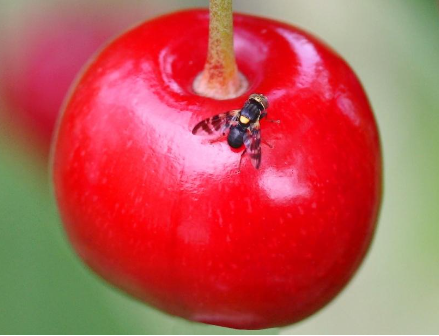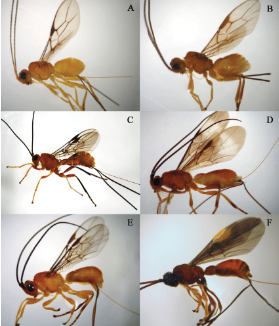Cherry fruit fly (Rhagoletis cerasi): The most crucial cherry tree pest

This post is also available in:
This post is also available in:
![]() Ελληνικά (Greek)
Ελληνικά (Greek)
The cherry fruit fly (Rhagoletis cerasi) is a pest with a significant role in cherry orchards worldwide. These tiny flies lay their eggs on ripe cherries, causing infestations that can cause substantial economic losses to farmers. Understanding the life cycle of the cherry fruit fly, recognizing its importance, and implementing effective countermeasures, including biological controls, are vital in facing this destructive pest.
What is the life cycle of a cherry fruit fly?
The cherry fruit fly life cycle consists of four stages:
- egg
- larva
- pupa
- adult
Adults hatch from overwintering pupae in the spring, usually coinciding with the flowering of the cherry blossoms. They are attracted to the aroma of ripe cherries, especially those about to ripen. Female flies lay their eggs under the skin of cherries, often resulting in dimples and egg-laying scars. Within a week, tiny larvae hatch from the eggs and feed on the pulp, causing significant damage. The larvae mature inside the cherry, drop into the ground, and pupate. After the pupation stage, adult flies hatch and complete their life cycle.
Cherry fruit fly infestations can seriously affect cherry trees. The eggs and larvae cause direct damage by feeding on the fruit, resulting in premature fruit drop, reduced yield, and poor fruit quality. In addition, wounds made by female flies during egg laying can provide entry points for secondary infection, which can further damage the fruit and possibly the entire tree. Left unmanaged, cherry fruit fly populations can increase and threaten the long-term viability of cherry orchards.
The life cycle of a cherry fruit fly video: https://www.youtube.com/watch?v=vEQyUtS4faU
Find more videos related to Pests in agriculture on the youtube channel: Entomozoom.
How do you control cherry fruit flies?
Controlling cherry flies requires an Integrated Pest Management (IPM) approach that combines different strategies. Cultural practices such as orchard hygiene, proper pruning, and early harvesting can help minimize the extent of infection. Physical barriers such as fine-mesh protective nets can be used to prevent adults from reaching the cherries. Chemical pesticides can be used judiciously.
Biological control and capture methods for cherry flies:
Biological control offers an environmentally friendly and sustainable approach to managing cherry fly populations. Natural enemies, such as parasitic wasps Hymenoptera: Braconidae or Hymenoptera: Ichneumonidae, can be used as biological control agents. These beneficial insects parasitize or prey on cherry fruit fly eggs, larvae, or pupae, effectively reducing pest populations. By implementing habitat modifications that facilitate the presence of these natural enemies, providing flowering plants can enhance their effectiveness.

Two of the most effective cherry fly control traps are sticky and decis traps.
Sticky trap:
These traps have a sticky surface that traps adult cherry fruit flies. The yellow color of the trap attracts flies, which will hook on contact. Glue traps should be placed strategically in the orchard and replaced when the glue is full or ineffective.

Decis trap:
These traps use pheromone baits to attract cherry fruit flies. When flies are attracted to the trap, they insert the trap’s holes and are captured. The trap also contains chemical insecticide, killing the flies. The bait should be changed according to the manufacturer’s instructions.

Conclusion
The cherry fruit fly (Rhagoletis cerasi) is a major challenge to cherry growers as their infestation can result in significant economic losses. By understanding the life cycle, recognizing its impact on cherry trees, and implementing comprehensive control measures, including biological control and trapping methods, farmers can reduce the damage caused by this pest.
Bibliography
- Integrated Management of European Cherry Fruit Fly Rhagoletis cerasi (L.): Situation in Switzerland and Europe https://www.ncbi.nlm.nih.gov/pmc/articles/PMC4553558/
- Western Cherry Fruit Fly in Utah Orchards January 2020 Diane Alston, Extension Entomologist • Marion Murray, Extension IPM Specialist
- Tree Fruit Insect Pests – Cherry Fruit Fly and Black Cherry Fruit Fly https://extension.psu.edu/tree-fruit-insect-pests-cherry-fruit-fly-and-black-cherry-fruit-fly
- Russo G., 1976. Agricultural Entomology. Special Part. Liguori Editore, Naples
- Phylogenetic studies of tephritid flies (Diptera, Tephritidae) and their symbiotic bacteria January 2009, Isabel Martinez-Sañudo









































































